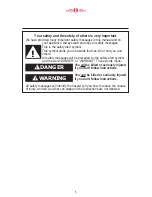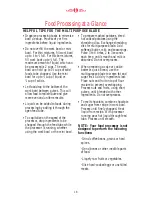
18
a
r
b
HELPFUL TIPS FOR THE MULTIPURPOSE BLADE
Food Processing at a Glance
• Organize processing tasks to minimize
bowl cleanup. Process dry or firm
ingredients before liquid ingredients.
• Do not overfill the work bowl or mini
bowl. For thin mixtures, fill work bowl
up to
1
⁄
3
to
1
⁄
2
full. For thicker mixtures,
fill work bowl up to
2
⁄
3
full. The
maximum amount of liquid which can
be processed is 2 cups. The work
bowl can hold up to 1
1
⁄
2
cups of solid
foods to be chopped. Use the mini
bowl for up to
2
⁄
3
cup of liquid or
3
⁄
4
cup of solids.
• Let food drop to the bottom of the
work bowl between pulses. This will
allow food to redistribute and give
more even and uniform results.
• Liquid can be added to foods during
processing by adding it through the
open feed tube.
• To capitalize on the speed of the
processor, drop ingredients to be
chopped through the feed tube while
the processor is running, whether
using the work bowl or the mini bowl.
• To prepare mashed potatoes, shred
hot cooked potatoes using the
shredding disc. Exchange shredding
disc for multipurpose blade. Add
softened butter, milk and seasonings.
Pulse 3 to 4 times, 2 to 3 seconds
each time, until smooth and milk is
absorbed. Do not overprocess.
• When preparing a cake or cookie
batter or quick bread, use the
multipurpose blade to cream fat and
sugar first. Add dry ingredients last.
Place nuts and fruit on top of flour
mixture to prevent overchopping.
Process nuts and fruits, using short
pulses, until blended with other
ingredients. Do not overprocess.
• To melt chocolate, combine chocolate
and sugar from recipe in work bowl.
Process until finely chopped. Heat
liquid from recipe. With processor
running pour hot liquid through feed
tube. Process until smooth.
NOTE: Your food processor is not
designed to perform the following
functions:
-Grind coffee beans, grains or hard
spices.
-Grind bones or other inedible parts
of food.
-Liquefy raw fruits or vegetables.
-Slice hard-cooked eggs or unchilled
meats.




































